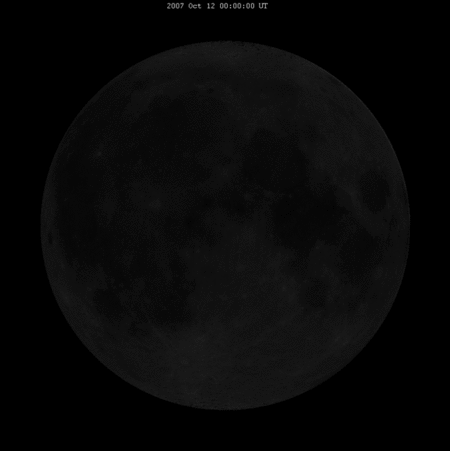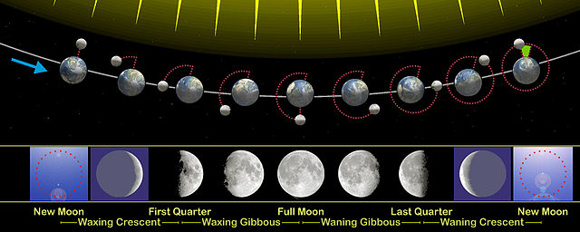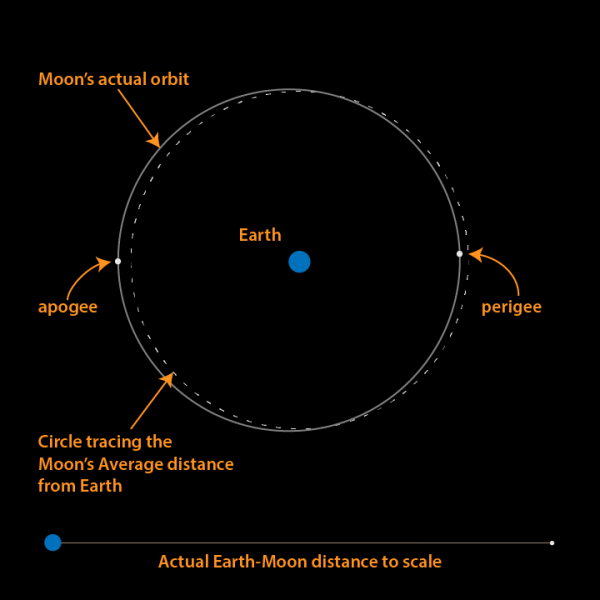
What are lunar months?
A lunar month is the duration between successive new moons. Also called a lunation or synodic month, it has a mean period of 29.53059 days (29 days 12 hours and 44 minutes). That’s the mean, but the the true length varies throughout the year.
Quite by coincidence, the lunar month straddling 2020 and 2021 – between the new moons of December 14, 2020, and January 13, 2021 – matches the mean lunar month of 29 days 12 hours and 44 minutes. The lunar month almost never equals the mean lunar month in duration. Most of the time, the true lunar month is either longer or shorter than the mean.
Keep reading to learn more about the lengths of lunar months in 2021.
Lengths of the lunar months in 2021
| Successive new moons | Length of lunar month |
| Dec 14, 2020, to Jan 13, 2021 | 29 days 12 hours 44 min |
| Jan 13 to Feb 11 | 29 days 14 hours 06 min |
| Feb 11 to Mar 13 | 29 days 15 hours 15 min |
| Mar 13 to Apr 12 | 29 days 16 hours 10 min |
| Apr 12 to May 11 | 29 days 16 hours 29 min |
| May 11 to Jun 10 | 29 days 15 hours 53 min |
| Jun 10 to Jul 9 | 29 days 14 hours 24 min |
| Jul 9 to Aug 8 | 29 days 12 hours 34 min |
| Aug 8 to Sep 6 | 29 days 11 hours 02 min |
| Sep 6 to Oct 6 | 29 days 10 hours 14 min |
| Oct 6 to Nov 4 | 29 days 10 hours 09 min |
| Nov 4 to Dec 4 | 29 days 10 hours 28 min |
| Dec 4, 2021, to Jan 2, 2022 | 29 days 10 hours 50 min |
Sources: Astropixels.com and TimeandDate.com

Why are the lunar months different lengths?
In a nutshell, the longest lunar month occurs when the successive new moons coincide closely with lunar apogee, the moon’s farthest point from Earth in its orbit.
In contrast, the year’s shortest lunar month takes place when the successive new moons fall appreciably close to lunar perigee – the moon’s closest point to Earth in its orbit.
On the average, the lunar month (new moon to new moon) is about 2.22 days longer than the sidereal month (one complete revolution of the moon relative to the background stars). However, if the moon is near apogee at the end of one sidereal month, the moon travels more slowly than average in its orbit. Therefore, the period of time between the end of the sidereal month and the end of the lunar month is longer than average.
The opposite is the case when the new moon is near perigee. The moon travels more swiftly in its orbit at perigee, in which case the time period between the end of the sidereal month and the end of the lunar month is less than average.
Dates for the 13 apogees and 13 perigees in 2021
The most extreme longest lunar months happen when successive new moons occur near lunar apogee – and in addition, when Earth is near perihelion (its closest point to the sun). Because Earth is always closest to the sun in early January, the very longest lunar months take place between December and January new moons.
On the other hand, extremely short lunar months happen when successive new moons fall near lunar perigee – and in addition, the Earth is near aphelion (Earth’s farthest point from the sun in its orbit). Because Earth is always at aphelion in early July, the very shortest lunar months take place between June and July new moons.
Enjoying EarthSky so far? Sign up for our free daily newsletter today!

When are the longest and shortest lunar months of the 21st century?
The longest lunar month of the 21st century (2001 to 2100) occurs between the December 2017 and January 2018 new moons. With a length of 29 days 19 hours and 47 minutes, this particular lunar month exceeds the mean by a whopping 7 hours and 3 minutes.
The century’s shortest lunar month takes place between the new moons of June and July 2053, a period of 29 days 6 hours and 35 minutes. That’s 6 hours and 9 minutes shorter than the mean.
Incidentally, exceptionally long or short lunar months repeat in cycles of 9 years.

Bottom line: In 2021, the longest lunar month happens between the April 12 and May 11 new moons, and the shortest one between the October 6 and November 4 new moons. See Astropixel.com’s complete list of the length of each lunar month in the 21st century.











